Occupational Health and Safety Program in Dermal Therapies Report
VerifiedAdded on 2020/01/07
|8
|2092
|222
Report
AI Summary
This report comprehensively addresses the crucial aspects of occupational health and safety (OHS) within the context of dermal therapies. It underscores the importance of OHS, particularly in mitigating risks associated with chemical exposures, which are prevalent in dermal settings. The report delves into the specifics of risk assessment, highlighting the need to identify potential hazards and implement appropriate control measures. It outlines standard operating procedures (SOPs) for various instruments and chemicals used, emphasizing the significance of regular equipment inspections, proper handling of hazardous substances, and the provision of personal protective equipment. Furthermore, the report discusses potential barriers to the successful implementation of OHS practices, such as underreporting and fear of retaliation, and concludes by outlining strategies for effective work health and safety management, including government initiatives and adherence to regulations. The report uses multiple sources to support its claims.

Standard operating procedures and occupational health and safety program within the dermal
therapies 1
Standard operating procedures and occupational health and safety program within the
dermal therapies
Student's Name:
Instructor's Name:
Date:
therapies 1
Standard operating procedures and occupational health and safety program within the
dermal therapies
Student's Name:
Instructor's Name:
Date:
Paraphrase This Document
Need a fresh take? Get an instant paraphrase of this document with our AI Paraphraser
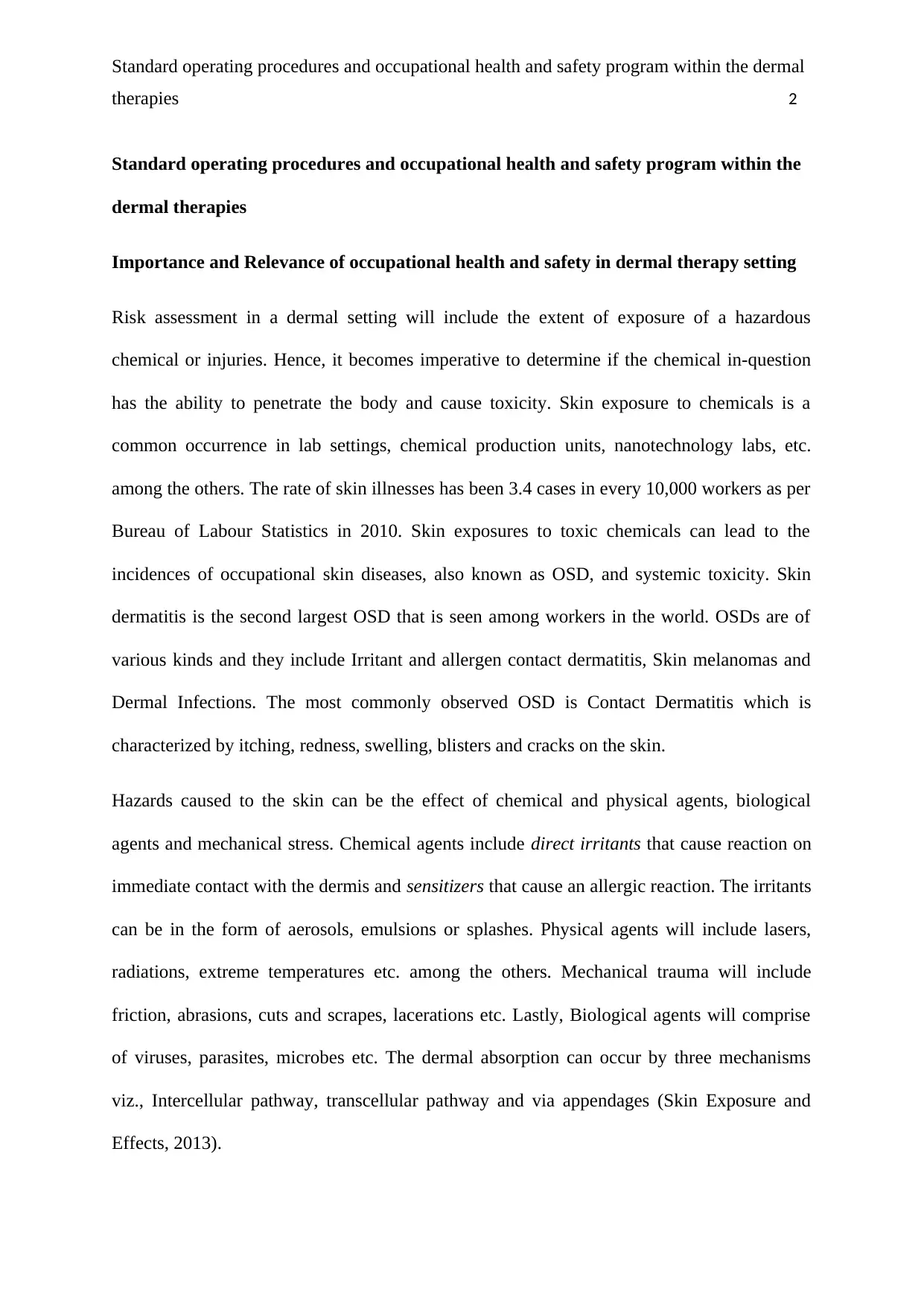
Standard operating procedures and occupational health and safety program within the dermal
therapies 2
Standard operating procedures and occupational health and safety program within the
dermal therapies
Importance and Relevance of occupational health and safety in dermal therapy setting
Risk assessment in a dermal setting will include the extent of exposure of a hazardous
chemical or injuries. Hence, it becomes imperative to determine if the chemical in-question
has the ability to penetrate the body and cause toxicity. Skin exposure to chemicals is a
common occurrence in lab settings, chemical production units, nanotechnology labs, etc.
among the others. The rate of skin illnesses has been 3.4 cases in every 10,000 workers as per
Bureau of Labour Statistics in 2010. Skin exposures to toxic chemicals can lead to the
incidences of occupational skin diseases, also known as OSD, and systemic toxicity. Skin
dermatitis is the second largest OSD that is seen among workers in the world. OSDs are of
various kinds and they include Irritant and allergen contact dermatitis, Skin melanomas and
Dermal Infections. The most commonly observed OSD is Contact Dermatitis which is
characterized by itching, redness, swelling, blisters and cracks on the skin.
Hazards caused to the skin can be the effect of chemical and physical agents, biological
agents and mechanical stress. Chemical agents include direct irritants that cause reaction on
immediate contact with the dermis and sensitizers that cause an allergic reaction. The irritants
can be in the form of aerosols, emulsions or splashes. Physical agents will include lasers,
radiations, extreme temperatures etc. among the others. Mechanical trauma will include
friction, abrasions, cuts and scrapes, lacerations etc. Lastly, Biological agents will comprise
of viruses, parasites, microbes etc. The dermal absorption can occur by three mechanisms
viz., Intercellular pathway, transcellular pathway and via appendages (Skin Exposure and
Effects, 2013).
therapies 2
Standard operating procedures and occupational health and safety program within the
dermal therapies
Importance and Relevance of occupational health and safety in dermal therapy setting
Risk assessment in a dermal setting will include the extent of exposure of a hazardous
chemical or injuries. Hence, it becomes imperative to determine if the chemical in-question
has the ability to penetrate the body and cause toxicity. Skin exposure to chemicals is a
common occurrence in lab settings, chemical production units, nanotechnology labs, etc.
among the others. The rate of skin illnesses has been 3.4 cases in every 10,000 workers as per
Bureau of Labour Statistics in 2010. Skin exposures to toxic chemicals can lead to the
incidences of occupational skin diseases, also known as OSD, and systemic toxicity. Skin
dermatitis is the second largest OSD that is seen among workers in the world. OSDs are of
various kinds and they include Irritant and allergen contact dermatitis, Skin melanomas and
Dermal Infections. The most commonly observed OSD is Contact Dermatitis which is
characterized by itching, redness, swelling, blisters and cracks on the skin.
Hazards caused to the skin can be the effect of chemical and physical agents, biological
agents and mechanical stress. Chemical agents include direct irritants that cause reaction on
immediate contact with the dermis and sensitizers that cause an allergic reaction. The irritants
can be in the form of aerosols, emulsions or splashes. Physical agents will include lasers,
radiations, extreme temperatures etc. among the others. Mechanical trauma will include
friction, abrasions, cuts and scrapes, lacerations etc. Lastly, Biological agents will comprise
of viruses, parasites, microbes etc. The dermal absorption can occur by three mechanisms
viz., Intercellular pathway, transcellular pathway and via appendages (Skin Exposure and
Effects, 2013).
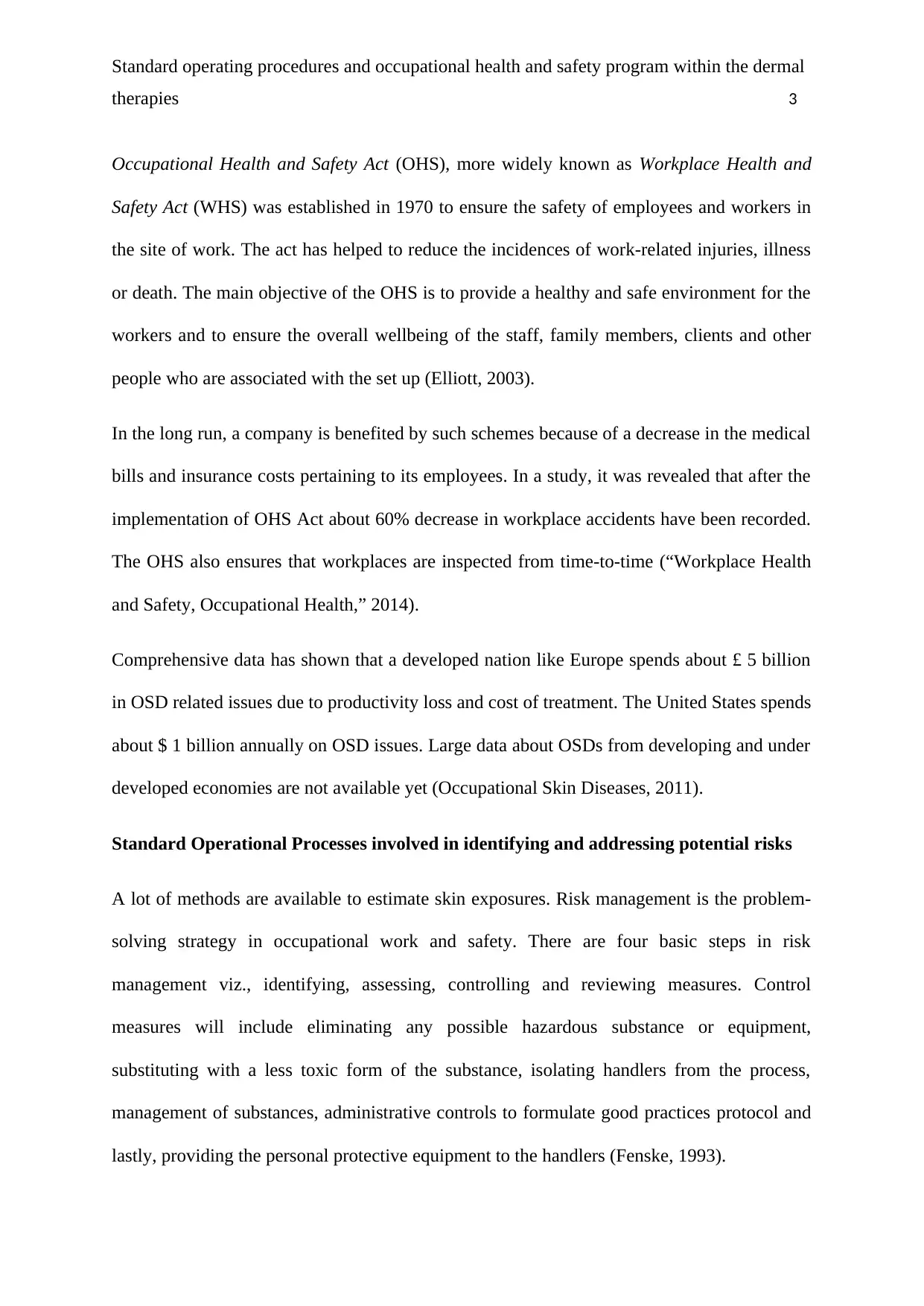
Standard operating procedures and occupational health and safety program within the dermal
therapies 3
Occupational Health and Safety Act (OHS), more widely known as Workplace Health and
Safety Act (WHS) was established in 1970 to ensure the safety of employees and workers in
the site of work. The act has helped to reduce the incidences of work-related injuries, illness
or death. The main objective of the OHS is to provide a healthy and safe environment for the
workers and to ensure the overall wellbeing of the staff, family members, clients and other
people who are associated with the set up (Elliott, 2003).
In the long run, a company is benefited by such schemes because of a decrease in the medical
bills and insurance costs pertaining to its employees. In a study, it was revealed that after the
implementation of OHS Act about 60% decrease in workplace accidents have been recorded.
The OHS also ensures that workplaces are inspected from time-to-time (“Workplace Health
and Safety, Occupational Health,” 2014).
Comprehensive data has shown that a developed nation like Europe spends about £ 5 billion
in OSD related issues due to productivity loss and cost of treatment. The United States spends
about $ 1 billion annually on OSD issues. Large data about OSDs from developing and under
developed economies are not available yet (Occupational Skin Diseases, 2011).
Standard Operational Processes involved in identifying and addressing potential risks
A lot of methods are available to estimate skin exposures. Risk management is the problem-
solving strategy in occupational work and safety. There are four basic steps in risk
management viz., identifying, assessing, controlling and reviewing measures. Control
measures will include eliminating any possible hazardous substance or equipment,
substituting with a less toxic form of the substance, isolating handlers from the process,
management of substances, administrative controls to formulate good practices protocol and
lastly, providing the personal protective equipment to the handlers (Fenske, 1993).
therapies 3
Occupational Health and Safety Act (OHS), more widely known as Workplace Health and
Safety Act (WHS) was established in 1970 to ensure the safety of employees and workers in
the site of work. The act has helped to reduce the incidences of work-related injuries, illness
or death. The main objective of the OHS is to provide a healthy and safe environment for the
workers and to ensure the overall wellbeing of the staff, family members, clients and other
people who are associated with the set up (Elliott, 2003).
In the long run, a company is benefited by such schemes because of a decrease in the medical
bills and insurance costs pertaining to its employees. In a study, it was revealed that after the
implementation of OHS Act about 60% decrease in workplace accidents have been recorded.
The OHS also ensures that workplaces are inspected from time-to-time (“Workplace Health
and Safety, Occupational Health,” 2014).
Comprehensive data has shown that a developed nation like Europe spends about £ 5 billion
in OSD related issues due to productivity loss and cost of treatment. The United States spends
about $ 1 billion annually on OSD issues. Large data about OSDs from developing and under
developed economies are not available yet (Occupational Skin Diseases, 2011).
Standard Operational Processes involved in identifying and addressing potential risks
A lot of methods are available to estimate skin exposures. Risk management is the problem-
solving strategy in occupational work and safety. There are four basic steps in risk
management viz., identifying, assessing, controlling and reviewing measures. Control
measures will include eliminating any possible hazardous substance or equipment,
substituting with a less toxic form of the substance, isolating handlers from the process,
management of substances, administrative controls to formulate good practices protocol and
lastly, providing the personal protective equipment to the handlers (Fenske, 1993).
⊘ This is a preview!⊘
Do you want full access?
Subscribe today to unlock all pages.

Trusted by 1+ million students worldwide
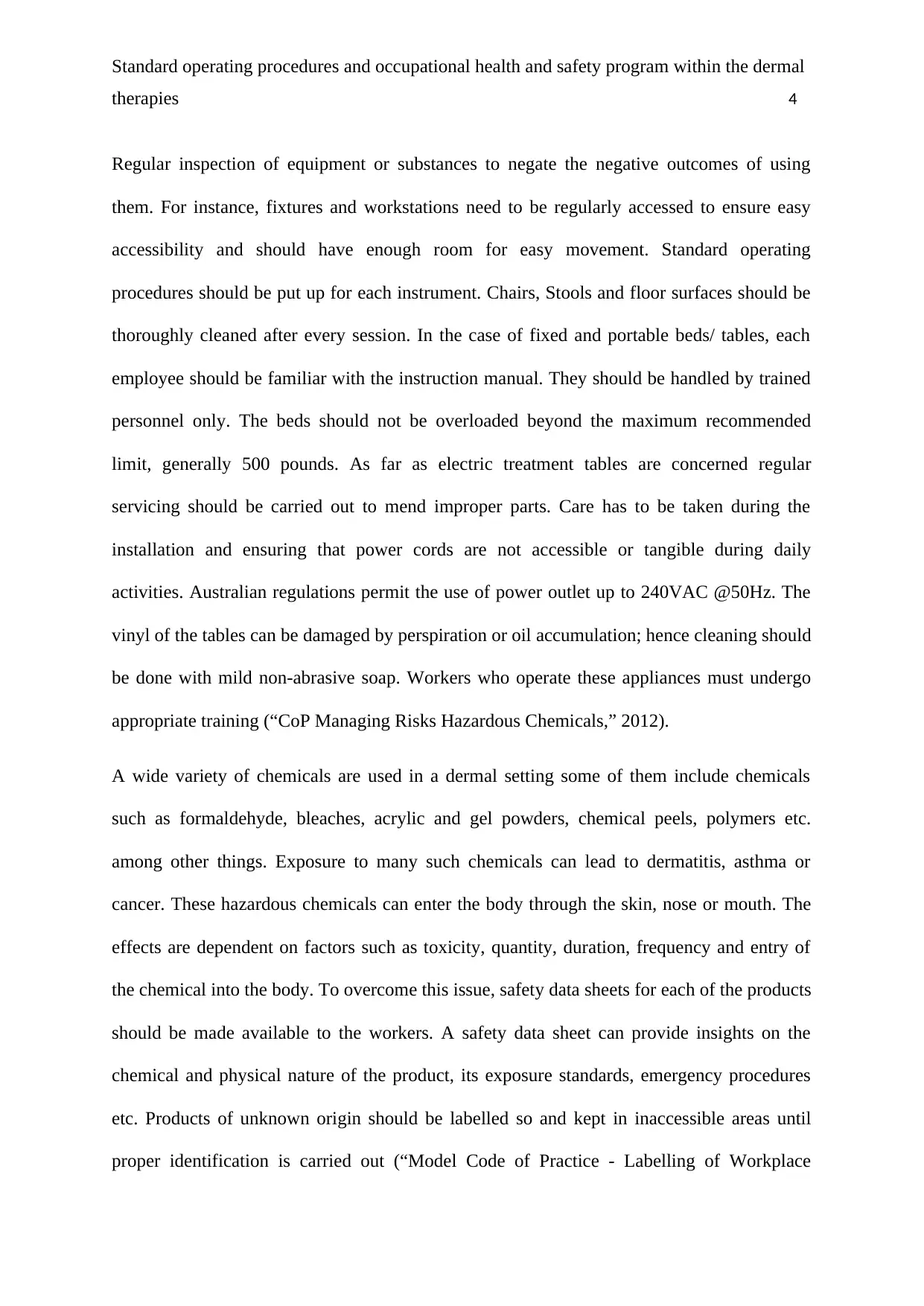
Standard operating procedures and occupational health and safety program within the dermal
therapies 4
Regular inspection of equipment or substances to negate the negative outcomes of using
them. For instance, fixtures and workstations need to be regularly accessed to ensure easy
accessibility and should have enough room for easy movement. Standard operating
procedures should be put up for each instrument. Chairs, Stools and floor surfaces should be
thoroughly cleaned after every session. In the case of fixed and portable beds/ tables, each
employee should be familiar with the instruction manual. They should be handled by trained
personnel only. The beds should not be overloaded beyond the maximum recommended
limit, generally 500 pounds. As far as electric treatment tables are concerned regular
servicing should be carried out to mend improper parts. Care has to be taken during the
installation and ensuring that power cords are not accessible or tangible during daily
activities. Australian regulations permit the use of power outlet up to 240VAC @50Hz. The
vinyl of the tables can be damaged by perspiration or oil accumulation; hence cleaning should
be done with mild non-abrasive soap. Workers who operate these appliances must undergo
appropriate training (“CoP Managing Risks Hazardous Chemicals,” 2012).
A wide variety of chemicals are used in a dermal setting some of them include chemicals
such as formaldehyde, bleaches, acrylic and gel powders, chemical peels, polymers etc.
among other things. Exposure to many such chemicals can lead to dermatitis, asthma or
cancer. These hazardous chemicals can enter the body through the skin, nose or mouth. The
effects are dependent on factors such as toxicity, quantity, duration, frequency and entry of
the chemical into the body. To overcome this issue, safety data sheets for each of the products
should be made available to the workers. A safety data sheet can provide insights on the
chemical and physical nature of the product, its exposure standards, emergency procedures
etc. Products of unknown origin should be labelled so and kept in inaccessible areas until
proper identification is carried out (“Model Code of Practice - Labelling of Workplace
therapies 4
Regular inspection of equipment or substances to negate the negative outcomes of using
them. For instance, fixtures and workstations need to be regularly accessed to ensure easy
accessibility and should have enough room for easy movement. Standard operating
procedures should be put up for each instrument. Chairs, Stools and floor surfaces should be
thoroughly cleaned after every session. In the case of fixed and portable beds/ tables, each
employee should be familiar with the instruction manual. They should be handled by trained
personnel only. The beds should not be overloaded beyond the maximum recommended
limit, generally 500 pounds. As far as electric treatment tables are concerned regular
servicing should be carried out to mend improper parts. Care has to be taken during the
installation and ensuring that power cords are not accessible or tangible during daily
activities. Australian regulations permit the use of power outlet up to 240VAC @50Hz. The
vinyl of the tables can be damaged by perspiration or oil accumulation; hence cleaning should
be done with mild non-abrasive soap. Workers who operate these appliances must undergo
appropriate training (“CoP Managing Risks Hazardous Chemicals,” 2012).
A wide variety of chemicals are used in a dermal setting some of them include chemicals
such as formaldehyde, bleaches, acrylic and gel powders, chemical peels, polymers etc.
among other things. Exposure to many such chemicals can lead to dermatitis, asthma or
cancer. These hazardous chemicals can enter the body through the skin, nose or mouth. The
effects are dependent on factors such as toxicity, quantity, duration, frequency and entry of
the chemical into the body. To overcome this issue, safety data sheets for each of the products
should be made available to the workers. A safety data sheet can provide insights on the
chemical and physical nature of the product, its exposure standards, emergency procedures
etc. Products of unknown origin should be labelled so and kept in inaccessible areas until
proper identification is carried out (“Model Code of Practice - Labelling of Workplace
Paraphrase This Document
Need a fresh take? Get an instant paraphrase of this document with our AI Paraphraser
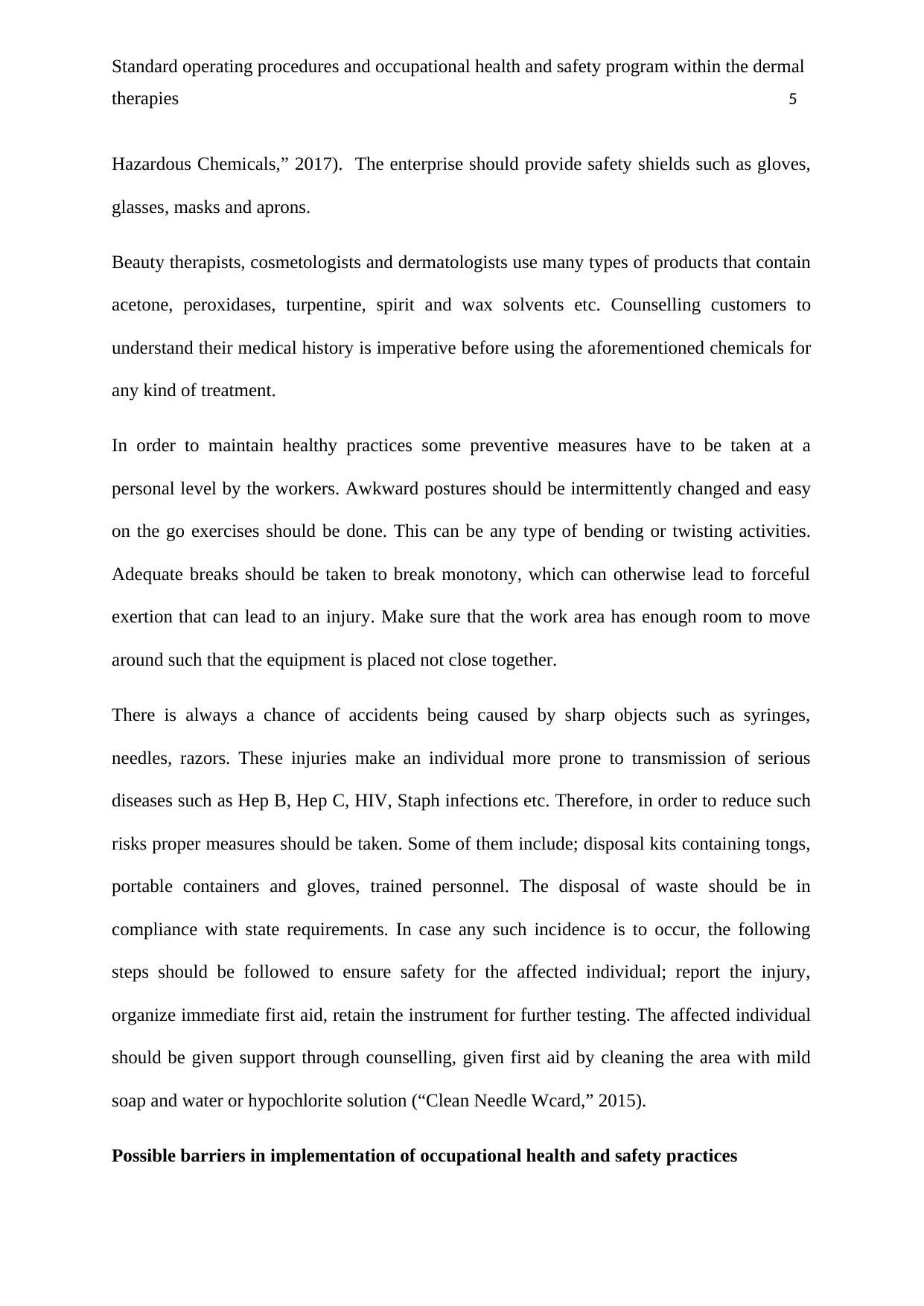
Standard operating procedures and occupational health and safety program within the dermal
therapies 5
Hazardous Chemicals,” 2017). The enterprise should provide safety shields such as gloves,
glasses, masks and aprons.
Beauty therapists, cosmetologists and dermatologists use many types of products that contain
acetone, peroxidases, turpentine, spirit and wax solvents etc. Counselling customers to
understand their medical history is imperative before using the aforementioned chemicals for
any kind of treatment.
In order to maintain healthy practices some preventive measures have to be taken at a
personal level by the workers. Awkward postures should be intermittently changed and easy
on the go exercises should be done. This can be any type of bending or twisting activities.
Adequate breaks should be taken to break monotony, which can otherwise lead to forceful
exertion that can lead to an injury. Make sure that the work area has enough room to move
around such that the equipment is placed not close together.
There is always a chance of accidents being caused by sharp objects such as syringes,
needles, razors. These injuries make an individual more prone to transmission of serious
diseases such as Hep B, Hep C, HIV, Staph infections etc. Therefore, in order to reduce such
risks proper measures should be taken. Some of them include; disposal kits containing tongs,
portable containers and gloves, trained personnel. The disposal of waste should be in
compliance with state requirements. In case any such incidence is to occur, the following
steps should be followed to ensure safety for the affected individual; report the injury,
organize immediate first aid, retain the instrument for further testing. The affected individual
should be given support through counselling, given first aid by cleaning the area with mild
soap and water or hypochlorite solution (“Clean Needle Wcard,” 2015).
Possible barriers in implementation of occupational health and safety practices
therapies 5
Hazardous Chemicals,” 2017). The enterprise should provide safety shields such as gloves,
glasses, masks and aprons.
Beauty therapists, cosmetologists and dermatologists use many types of products that contain
acetone, peroxidases, turpentine, spirit and wax solvents etc. Counselling customers to
understand their medical history is imperative before using the aforementioned chemicals for
any kind of treatment.
In order to maintain healthy practices some preventive measures have to be taken at a
personal level by the workers. Awkward postures should be intermittently changed and easy
on the go exercises should be done. This can be any type of bending or twisting activities.
Adequate breaks should be taken to break monotony, which can otherwise lead to forceful
exertion that can lead to an injury. Make sure that the work area has enough room to move
around such that the equipment is placed not close together.
There is always a chance of accidents being caused by sharp objects such as syringes,
needles, razors. These injuries make an individual more prone to transmission of serious
diseases such as Hep B, Hep C, HIV, Staph infections etc. Therefore, in order to reduce such
risks proper measures should be taken. Some of them include; disposal kits containing tongs,
portable containers and gloves, trained personnel. The disposal of waste should be in
compliance with state requirements. In case any such incidence is to occur, the following
steps should be followed to ensure safety for the affected individual; report the injury,
organize immediate first aid, retain the instrument for further testing. The affected individual
should be given support through counselling, given first aid by cleaning the area with mild
soap and water or hypochlorite solution (“Clean Needle Wcard,” 2015).
Possible barriers in implementation of occupational health and safety practices
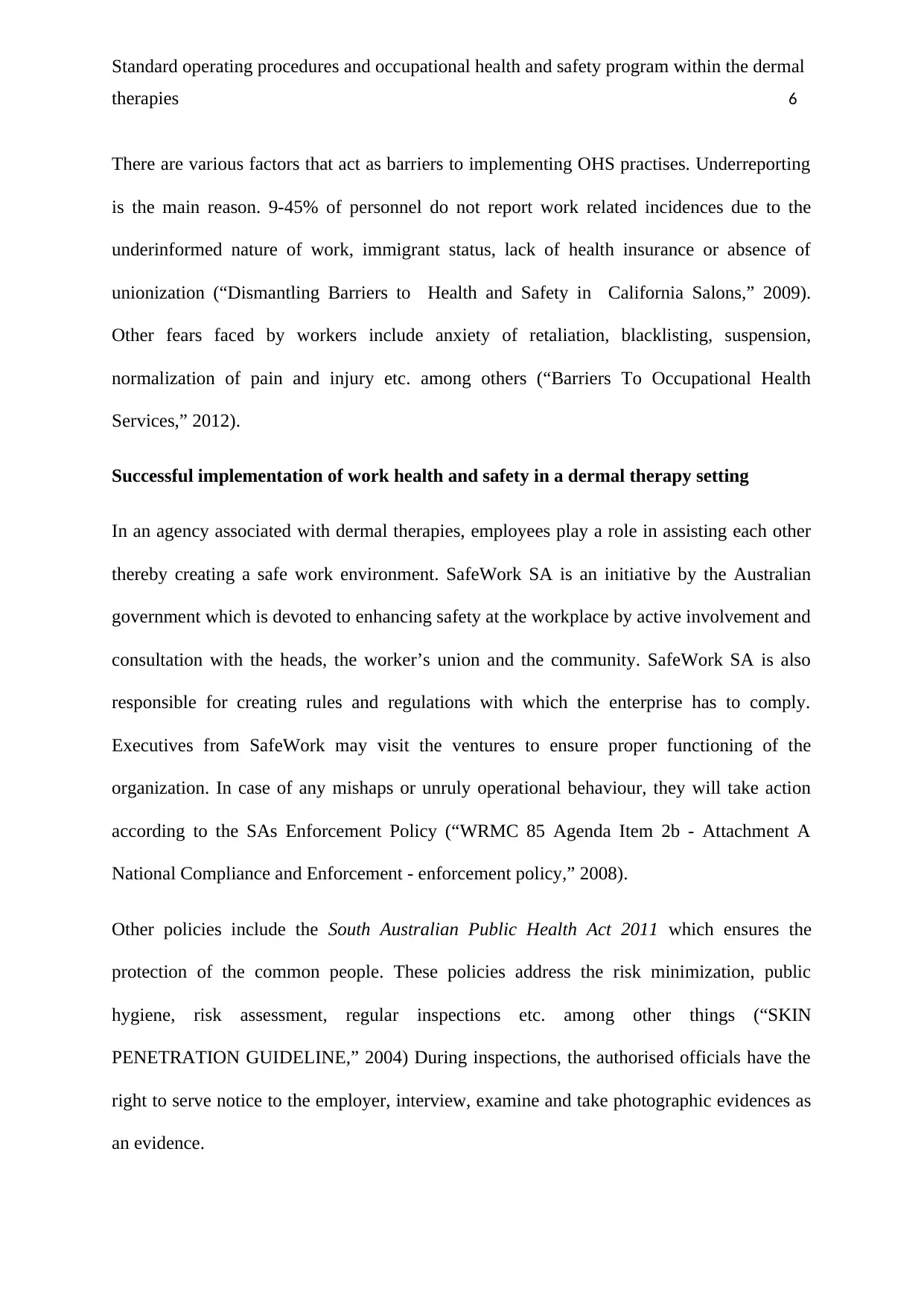
Standard operating procedures and occupational health and safety program within the dermal
therapies 6
There are various factors that act as barriers to implementing OHS practises. Underreporting
is the main reason. 9-45% of personnel do not report work related incidences due to the
underinformed nature of work, immigrant status, lack of health insurance or absence of
unionization (“Dismantling Barriers to Health and Safety in California Salons,” 2009).
Other fears faced by workers include anxiety of retaliation, blacklisting, suspension,
normalization of pain and injury etc. among others (“Barriers To Occupational Health
Services,” 2012).
Successful implementation of work health and safety in a dermal therapy setting
In an agency associated with dermal therapies, employees play a role in assisting each other
thereby creating a safe work environment. SafeWork SA is an initiative by the Australian
government which is devoted to enhancing safety at the workplace by active involvement and
consultation with the heads, the worker’s union and the community. SafeWork SA is also
responsible for creating rules and regulations with which the enterprise has to comply.
Executives from SafeWork may visit the ventures to ensure proper functioning of the
organization. In case of any mishaps or unruly operational behaviour, they will take action
according to the SAs Enforcement Policy (“WRMC 85 Agenda Item 2b - Attachment A
National Compliance and Enforcement - enforcement policy,” 2008).
Other policies include the South Australian Public Health Act 2011 which ensures the
protection of the common people. These policies address the risk minimization, public
hygiene, risk assessment, regular inspections etc. among other things (“SKIN
PENETRATION GUIDELINE,” 2004) During inspections, the authorised officials have the
right to serve notice to the employer, interview, examine and take photographic evidences as
an evidence.
therapies 6
There are various factors that act as barriers to implementing OHS practises. Underreporting
is the main reason. 9-45% of personnel do not report work related incidences due to the
underinformed nature of work, immigrant status, lack of health insurance or absence of
unionization (“Dismantling Barriers to Health and Safety in California Salons,” 2009).
Other fears faced by workers include anxiety of retaliation, blacklisting, suspension,
normalization of pain and injury etc. among others (“Barriers To Occupational Health
Services,” 2012).
Successful implementation of work health and safety in a dermal therapy setting
In an agency associated with dermal therapies, employees play a role in assisting each other
thereby creating a safe work environment. SafeWork SA is an initiative by the Australian
government which is devoted to enhancing safety at the workplace by active involvement and
consultation with the heads, the worker’s union and the community. SafeWork SA is also
responsible for creating rules and regulations with which the enterprise has to comply.
Executives from SafeWork may visit the ventures to ensure proper functioning of the
organization. In case of any mishaps or unruly operational behaviour, they will take action
according to the SAs Enforcement Policy (“WRMC 85 Agenda Item 2b - Attachment A
National Compliance and Enforcement - enforcement policy,” 2008).
Other policies include the South Australian Public Health Act 2011 which ensures the
protection of the common people. These policies address the risk minimization, public
hygiene, risk assessment, regular inspections etc. among other things (“SKIN
PENETRATION GUIDELINE,” 2004) During inspections, the authorised officials have the
right to serve notice to the employer, interview, examine and take photographic evidences as
an evidence.
⊘ This is a preview!⊘
Do you want full access?
Subscribe today to unlock all pages.

Trusted by 1+ million students worldwide
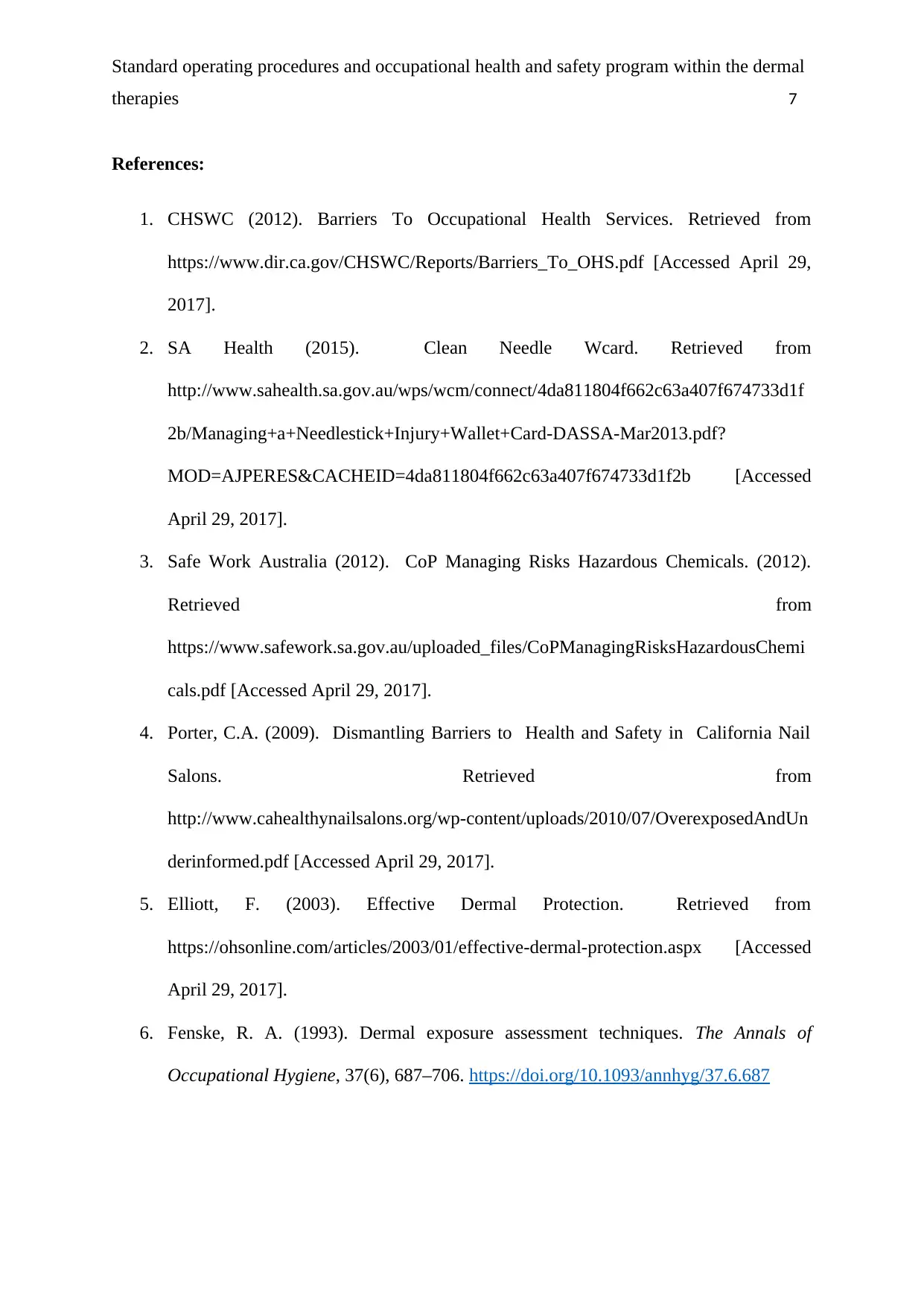
Standard operating procedures and occupational health and safety program within the dermal
therapies 7
References:
1. CHSWC (2012). Barriers To Occupational Health Services. Retrieved from
https://www.dir.ca.gov/CHSWC/Reports/Barriers_To_OHS.pdf [Accessed April 29,
2017].
2. SA Health (2015). Clean Needle Wcard. Retrieved from
http://www.sahealth.sa.gov.au/wps/wcm/connect/4da811804f662c63a407f674733d1f
2b/Managing+a+Needlestick+Injury+Wallet+Card-DASSA-Mar2013.pdf?
MOD=AJPERES&CACHEID=4da811804f662c63a407f674733d1f2b [Accessed
April 29, 2017].
3. Safe Work Australia (2012). CoP Managing Risks Hazardous Chemicals. (2012).
Retrieved from
https://www.safework.sa.gov.au/uploaded_files/CoPManagingRisksHazardousChemi
cals.pdf [Accessed April 29, 2017].
4. Porter, C.A. (2009). Dismantling Barriers to Health and Safety in California Nail
Salons. Retrieved from
http://www.cahealthynailsalons.org/wp-content/uploads/2010/07/OverexposedAndUn
derinformed.pdf [Accessed April 29, 2017].
5. Elliott, F. (2003). Effective Dermal Protection. Retrieved from
https://ohsonline.com/articles/2003/01/effective-dermal-protection.aspx [Accessed
April 29, 2017].
6. Fenske, R. A. (1993). Dermal exposure assessment techniques. The Annals of
Occupational Hygiene, 37(6), 687–706. https://doi.org/10.1093/annhyg/37.6.687
therapies 7
References:
1. CHSWC (2012). Barriers To Occupational Health Services. Retrieved from
https://www.dir.ca.gov/CHSWC/Reports/Barriers_To_OHS.pdf [Accessed April 29,
2017].
2. SA Health (2015). Clean Needle Wcard. Retrieved from
http://www.sahealth.sa.gov.au/wps/wcm/connect/4da811804f662c63a407f674733d1f
2b/Managing+a+Needlestick+Injury+Wallet+Card-DASSA-Mar2013.pdf?
MOD=AJPERES&CACHEID=4da811804f662c63a407f674733d1f2b [Accessed
April 29, 2017].
3. Safe Work Australia (2012). CoP Managing Risks Hazardous Chemicals. (2012).
Retrieved from
https://www.safework.sa.gov.au/uploaded_files/CoPManagingRisksHazardousChemi
cals.pdf [Accessed April 29, 2017].
4. Porter, C.A. (2009). Dismantling Barriers to Health and Safety in California Nail
Salons. Retrieved from
http://www.cahealthynailsalons.org/wp-content/uploads/2010/07/OverexposedAndUn
derinformed.pdf [Accessed April 29, 2017].
5. Elliott, F. (2003). Effective Dermal Protection. Retrieved from
https://ohsonline.com/articles/2003/01/effective-dermal-protection.aspx [Accessed
April 29, 2017].
6. Fenske, R. A. (1993). Dermal exposure assessment techniques. The Annals of
Occupational Hygiene, 37(6), 687–706. https://doi.org/10.1093/annhyg/37.6.687
Paraphrase This Document
Need a fresh take? Get an instant paraphrase of this document with our AI Paraphraser
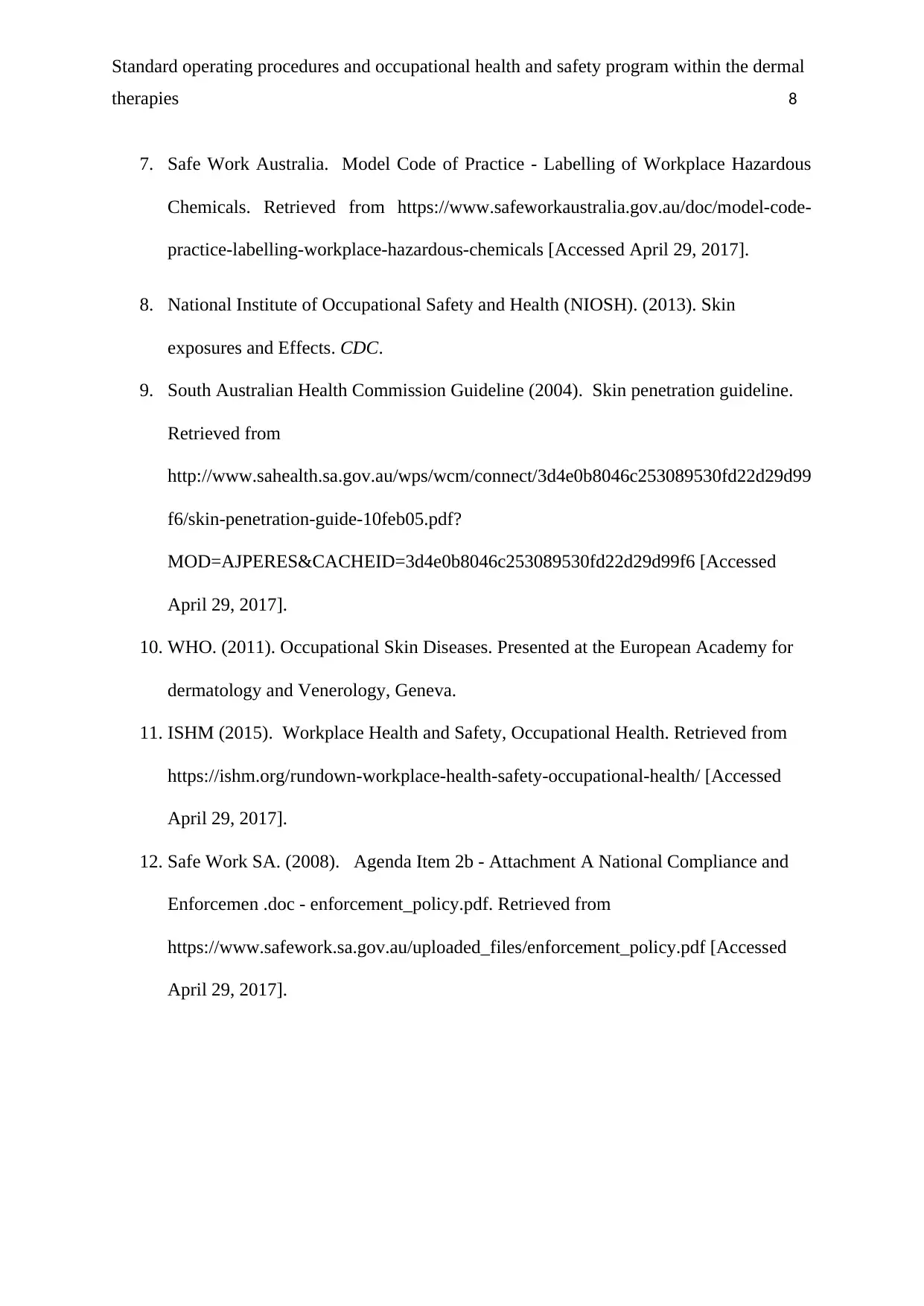
Standard operating procedures and occupational health and safety program within the dermal
therapies 8
7. Safe Work Australia. Model Code of Practice - Labelling of Workplace Hazardous
Chemicals. Retrieved from https://www.safeworkaustralia.gov.au/doc/model-code-
practice-labelling-workplace-hazardous-chemicals [Accessed April 29, 2017].
8. National Institute of Occupational Safety and Health (NIOSH). (2013). Skin
exposures and Effects. CDC.
9. South Australian Health Commission Guideline (2004). Skin penetration guideline.
Retrieved from
http://www.sahealth.sa.gov.au/wps/wcm/connect/3d4e0b8046c253089530fd22d29d99
f6/skin-penetration-guide-10feb05.pdf?
MOD=AJPERES&CACHEID=3d4e0b8046c253089530fd22d29d99f6 [Accessed
April 29, 2017].
10. WHO. (2011). Occupational Skin Diseases. Presented at the European Academy for
dermatology and Venerology, Geneva.
11. ISHM (2015). Workplace Health and Safety, Occupational Health. Retrieved from
https://ishm.org/rundown-workplace-health-safety-occupational-health/ [Accessed
April 29, 2017].
12. Safe Work SA. (2008). Agenda Item 2b - Attachment A National Compliance and
Enforcemen .doc - enforcement_policy.pdf. Retrieved from
https://www.safework.sa.gov.au/uploaded_files/enforcement_policy.pdf [Accessed
April 29, 2017].
therapies 8
7. Safe Work Australia. Model Code of Practice - Labelling of Workplace Hazardous
Chemicals. Retrieved from https://www.safeworkaustralia.gov.au/doc/model-code-
practice-labelling-workplace-hazardous-chemicals [Accessed April 29, 2017].
8. National Institute of Occupational Safety and Health (NIOSH). (2013). Skin
exposures and Effects. CDC.
9. South Australian Health Commission Guideline (2004). Skin penetration guideline.
Retrieved from
http://www.sahealth.sa.gov.au/wps/wcm/connect/3d4e0b8046c253089530fd22d29d99
f6/skin-penetration-guide-10feb05.pdf?
MOD=AJPERES&CACHEID=3d4e0b8046c253089530fd22d29d99f6 [Accessed
April 29, 2017].
10. WHO. (2011). Occupational Skin Diseases. Presented at the European Academy for
dermatology and Venerology, Geneva.
11. ISHM (2015). Workplace Health and Safety, Occupational Health. Retrieved from
https://ishm.org/rundown-workplace-health-safety-occupational-health/ [Accessed
April 29, 2017].
12. Safe Work SA. (2008). Agenda Item 2b - Attachment A National Compliance and
Enforcemen .doc - enforcement_policy.pdf. Retrieved from
https://www.safework.sa.gov.au/uploaded_files/enforcement_policy.pdf [Accessed
April 29, 2017].
1 out of 8
Related Documents
Your All-in-One AI-Powered Toolkit for Academic Success.
+13062052269
info@desklib.com
Available 24*7 on WhatsApp / Email
![[object Object]](/_next/static/media/star-bottom.7253800d.svg)
Unlock your academic potential
Copyright © 2020–2025 A2Z Services. All Rights Reserved. Developed and managed by ZUCOL.





